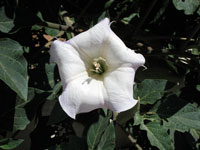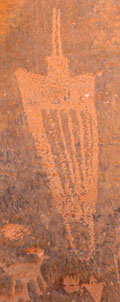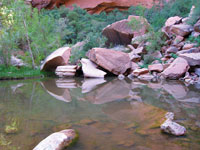HIKING HAPPENINGS
July 2009
Moonflower Canyon – Summer Time Delight
by Marcia Hafner
During our “hot as hell” summer season it can be very hard to keep your cool, especially when you are feeling antsy for a hike. But in order to avoid a meltdown you have to hit the trail extremely early - like the crack of dawn. If rousing yourself up out of bed with the roosters has no appeal, don’t despair. There are some cool spots close to town and the tree-lined trail in Moonflower Canyon, which offers refreshing shade all day long, is particularly appealing at this time of year.
 The namesake for this canyon is the sacred datura, a perennial plant related to tobacco and more commonly known as moonflower because it is a night bloomer. It is in the twilight of the day that a dramatic transformation occurs. That’s when the cigar-like-petals open up into the white Cinderella beauty of a large trumpet-shaped flower. Under the cloak of darkness, its sweetly scented fragrance pours forth into the invigorating night air to attract the sphinx moth and other nocturnal pollinators. In clear weather, the opening of this handsome flower happens at dusk and withers away a few hours after sunrise, but on dark cloudy days, it has a tendency to open earlier and linger longer the next morning. The namesake for this canyon is the sacred datura, a perennial plant related to tobacco and more commonly known as moonflower because it is a night bloomer. It is in the twilight of the day that a dramatic transformation occurs. That’s when the cigar-like-petals open up into the white Cinderella beauty of a large trumpet-shaped flower. Under the cloak of darkness, its sweetly scented fragrance pours forth into the invigorating night air to attract the sphinx moth and other nocturnal pollinators. In clear weather, the opening of this handsome flower happens at dusk and withers away a few hours after sunrise, but on dark cloudy days, it has a tendency to open earlier and linger longer the next morning.
Also known as jimsonweed, sacred datura contains toxic alkaloids as a protection against herbivores. Various Native American tribes harvested the large hallucinogenic leaves and used them in their rites of passage and religious ceremonies to induce visions, and there is speculation that these practices were probably performed in Moonflower Canyon. Among the Chumash, at the age of eight, a boy was given a preparation of “momoy” to drink as a spiritual challenge to help him develop the well being required in a man. This narcotic substance was also used to tell the future, especially when gambling.
To access the shaded refuge that exists within Moonflower Canyon from the center of town, go south on Main Street to the fast food corner of McDonald’s and Burger King. Then turn right at the light on to Kane Creek Boulevard and proceed three miles to the parking area on the left side of the road.
At the mouth of the canyon the Bureau of Land Management has set up eight rustic “walk-in” campsites and these appealing spots are well worth the extra effort. There is no drinking water or trash containers, but pit toilet facilities are available near the parking area.
 The Moonflower Canyon petroglyphs, located at the beginning of the canyon, represent the Archaic and Formative periods of time, when Native Americans recorded their visions, clan symbols and current events into the sandstone walls. The Archaic refers to the nomadic hunters and gatherers who regularly passed through our region 8,000 to 9,000 years ago. The Formative came about 1300 to 2000 years ago when the practice of farming made the establishment of permanent villages possible. The large triangular figure wearing a headdress in this outdoor gallery represents the Barrier Canyon style. Also depicted on the panel are deer, bighorn sheep and a number of abstract elements. To the left of the panel inhabitants from a long time ago constructed a ladder by jamming logs into a crack of the rock wall. Historically they climbed this precarious route to gain access to higher mesas within the area. The Moonflower Canyon petroglyphs, located at the beginning of the canyon, represent the Archaic and Formative periods of time, when Native Americans recorded their visions, clan symbols and current events into the sandstone walls. The Archaic refers to the nomadic hunters and gatherers who regularly passed through our region 8,000 to 9,000 years ago. The Formative came about 1300 to 2000 years ago when the practice of farming made the establishment of permanent villages possible. The large triangular figure wearing a headdress in this outdoor gallery represents the Barrier Canyon style. Also depicted on the panel are deer, bighorn sheep and a number of abstract elements. To the left of the panel inhabitants from a long time ago constructed a ladder by jamming logs into a crack of the rock wall. Historically they climbed this precarious route to gain access to higher mesas within the area.
It is just half a mile walk on a gentle, sandy trail to the end of this box canyon. Beware of the poison ivy that grows unnervingly close to the edge of the walkway. This expansive sheer-walled canyon is within the boundaries of Behind the Rocks Wilderness Study Area, and as you move deeper into the canyon, noises from the busy road fade away. The thickness and variety of vegetation throughout the canyon bottom that includes willows, grasses, milkweed, rabbitbrush, Gambel’s oak and cottonwood trees makes me feel as though I’m walking through a botanical garden. The cottonwoods, especially at the beginning of the canyon, have a huge girth. All this lushness is an oasis for birds that makes for great bird watching opportunities. During my afternoon stroll I either saw or heard Say’s phoebe, yellow-breasted chat, white-throated swift, raven, mourning dove, spotted towhee, violet-green swallow, canyon wren, robin, house finch, and ash-throated flycatcher.
In the spring wildflowers such as Indian paintbrush and scarlet gilia grow in happy profusion along the wash of the intermittent stream. Late spring and early summer red pentstemon, Prince’s plume, globemallow, yellow sweet clover, and golden asters have their big fling.
A small alcove near campsite six harbors a hanging garden where the steady drip of water promotes the growth of the cave primrose. The appearance of this pinkish-purple flower with a bright yellow center coincides with the Easter season; consequently it is sometimes referred to as the “Easter flower.” After the primrose have passed their prime, the Eastwood monkey-flowers take over with their own brilliant dash of scarlet blooms.
 The trail abruptly ends at a vertical pour-off where a small spring-fed pond is the perfect spot on an overly toasty day – an idyllic place to wile away a lazy summer afternoon, where aquatic insects such as water skimmers, boatmen and beetles are fascinating to watch as they go through the daily routine of their watery world. Tiny pale blue flowers relish the moisture in the damp areas along the stream that trickles out of the pond. The towering cliff walls throw off deep solid shade, encasing me in moist shadows that feel like an outdoor evaporative cooler. The pond, bordered with huge boulders on one side and grasses on the opposite bank, presents a sharp contrast of green vegetation against deep brown sandstone walls – the ying and yang of warm versus cool, dry versus damp on an almost perfectly motionless day. No one else is here, and I relish the soothing tranquility as a mourning cloak butterfly makes its back and forth fluttery flight, while the locusts crank out their whiny tune. The trail abruptly ends at a vertical pour-off where a small spring-fed pond is the perfect spot on an overly toasty day – an idyllic place to wile away a lazy summer afternoon, where aquatic insects such as water skimmers, boatmen and beetles are fascinating to watch as they go through the daily routine of their watery world. Tiny pale blue flowers relish the moisture in the damp areas along the stream that trickles out of the pond. The towering cliff walls throw off deep solid shade, encasing me in moist shadows that feel like an outdoor evaporative cooler. The pond, bordered with huge boulders on one side and grasses on the opposite bank, presents a sharp contrast of green vegetation against deep brown sandstone walls – the ying and yang of warm versus cool, dry versus damp on an almost perfectly motionless day. No one else is here, and I relish the soothing tranquility as a mourning cloak butterfly makes its back and forth fluttery flight, while the locusts crank out their whiny tune.
In Moonflower Canyon I have found what I’ve been longing for – blessed relief from the blazing heat. So if you are looking for a cool outdoor respite on a hot summer day that is close to town, this canyon is for you - the cool refreshment just might entice you to linger much longer than you planned.
Some additional information: The 527 square miles of Canyonlands became a national park in 1964. It is segmented into three distinct areas – Island In the Sky, (north) The Needles (south) and The Maze (west) and has two major rivers, The Green and The Colorado running through it. Island In The Sky and The Needles are easily accessible with any vehicle, but to visit The Maze, a high-clearance, four-wheel drive is required.
|
Biological Soil Crust (aka)
Cryptos (krip’ tose):
The surface of
Moab’s desert is held
together by a thin skin of living organisms known as cryptobiotic
soil or cryptos. It has a lumpy black appearance, is very
fragile, and takes decades to heal when it has been damaged.
This soil is a critical part of the survival of the desert.
The cryptobiotic organisms help to stabilize the soil, hold
moisture, and provide protection for germination of the seeds
of other plants. Without it the dry areas of the west would
be much different. Although some disturbance is normal and
helps the soil to capture moisture, excessive disturbance
by hooves, bicycle tires and hiking boots has been shown
to destroy the cryptobiotic organisms and their contribution
to the soil. When you walk around Moab avoid crushing the
cryptos. Stay on trails, walk in washes, hop from stone to
stone. Whatever it takes, don’t crunch the cryptos
unless you absolutely have to! |

Cryptobiotic soil garden
|
|
|
 The namesake for this canyon is the sacred datura, a perennial plant related to tobacco and more commonly known as moonflower because it is a night bloomer. It is in the twilight of the day that a dramatic transformation occurs. That’s when the cigar-like-petals open up into the white Cinderella beauty of a large trumpet-shaped flower. Under the cloak of darkness, its sweetly scented fragrance pours forth into the invigorating night air to attract the sphinx moth and other nocturnal pollinators. In clear weather, the opening of this handsome flower happens at dusk and withers away a few hours after sunrise, but on dark cloudy days, it has a tendency to open earlier and linger longer the next morning.
The namesake for this canyon is the sacred datura, a perennial plant related to tobacco and more commonly known as moonflower because it is a night bloomer. It is in the twilight of the day that a dramatic transformation occurs. That’s when the cigar-like-petals open up into the white Cinderella beauty of a large trumpet-shaped flower. Under the cloak of darkness, its sweetly scented fragrance pours forth into the invigorating night air to attract the sphinx moth and other nocturnal pollinators. In clear weather, the opening of this handsome flower happens at dusk and withers away a few hours after sunrise, but on dark cloudy days, it has a tendency to open earlier and linger longer the next morning. The Moonflower Canyon petroglyphs, located at the beginning of the canyon, represent the Archaic and Formative periods of time, when Native Americans recorded their visions, clan symbols and current events into the sandstone walls. The Archaic refers to the nomadic hunters and gatherers who regularly passed through our region 8,000 to 9,000 years ago. The Formative came about 1300 to 2000 years ago when the practice of farming made the establishment of permanent villages possible. The large triangular figure wearing a headdress in this outdoor gallery represents the Barrier Canyon style. Also depicted on the panel are deer, bighorn sheep and a number of abstract elements. To the left of the panel inhabitants from a long time ago constructed a ladder by jamming logs into a crack of the rock wall. Historically they climbed this precarious route to gain access to higher mesas within the area.
The Moonflower Canyon petroglyphs, located at the beginning of the canyon, represent the Archaic and Formative periods of time, when Native Americans recorded their visions, clan symbols and current events into the sandstone walls. The Archaic refers to the nomadic hunters and gatherers who regularly passed through our region 8,000 to 9,000 years ago. The Formative came about 1300 to 2000 years ago when the practice of farming made the establishment of permanent villages possible. The large triangular figure wearing a headdress in this outdoor gallery represents the Barrier Canyon style. Also depicted on the panel are deer, bighorn sheep and a number of abstract elements. To the left of the panel inhabitants from a long time ago constructed a ladder by jamming logs into a crack of the rock wall. Historically they climbed this precarious route to gain access to higher mesas within the area. The trail abruptly ends at a vertical pour-off where a small spring-fed pond is the perfect spot on an overly toasty day – an idyllic place to wile away a lazy summer afternoon, where aquatic insects such as water skimmers, boatmen and beetles are fascinating to watch as they go through the daily routine of their watery world. Tiny pale blue flowers relish the moisture in the damp areas along the stream that trickles out of the pond. The towering cliff walls throw off deep solid shade, encasing me in moist shadows that feel like an outdoor evaporative cooler. The pond, bordered with huge boulders on one side and grasses on the opposite bank, presents a sharp contrast of green vegetation against deep brown sandstone walls – the ying and yang of warm versus cool, dry versus damp on an almost perfectly motionless day. No one else is here, and I relish the soothing tranquility as a mourning cloak butterfly makes its back and forth fluttery flight, while the locusts crank out their whiny tune.
The trail abruptly ends at a vertical pour-off where a small spring-fed pond is the perfect spot on an overly toasty day – an idyllic place to wile away a lazy summer afternoon, where aquatic insects such as water skimmers, boatmen and beetles are fascinating to watch as they go through the daily routine of their watery world. Tiny pale blue flowers relish the moisture in the damp areas along the stream that trickles out of the pond. The towering cliff walls throw off deep solid shade, encasing me in moist shadows that feel like an outdoor evaporative cooler. The pond, bordered with huge boulders on one side and grasses on the opposite bank, presents a sharp contrast of green vegetation against deep brown sandstone walls – the ying and yang of warm versus cool, dry versus damp on an almost perfectly motionless day. No one else is here, and I relish the soothing tranquility as a mourning cloak butterfly makes its back and forth fluttery flight, while the locusts crank out their whiny tune. 